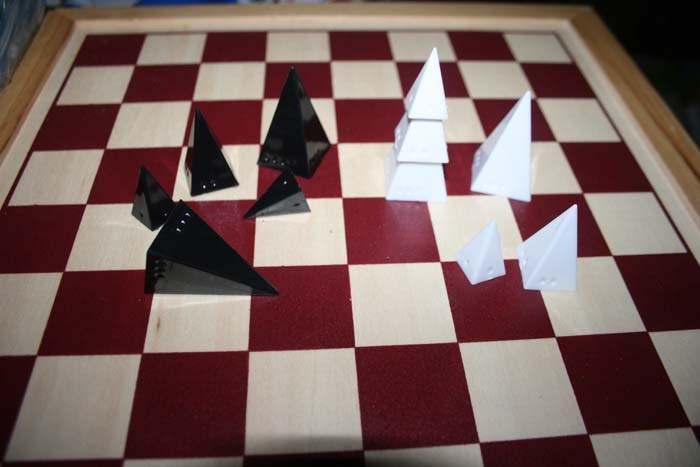So where did summer go?
It’s hard to believe the calendar has already flipped to September, but alas fall is upon us.
To mark the new season I’m going to embark on a themed-month of reviews, revolving around the ‘Looney Pyramid’.
If you haven’t heard of the pyramids, well you are about to find out about one of the coolest ‘gaming concepts’ to come along in recent years (actually the idea first launched back in 1987.
To start I’ll rely on the company behind the pyramids to explain they are not a game per say, but rather the basic pieces which have been utilized in a huge range of games from designers through the years since their release (a few of which will be looked at in more detail through the remainder of September.
“The pyramids are not so much a game, as a game system - like a deck of playing cards, a set of components that can be used to play all sorts of different games. And here at Looney Labs we have been making and playing pyramid games for almost 25 years,” noted www.looneylabs.com
“Traditionally, they were known as Icehouse pieces, since Icehouse was the first pyramid game that launched the system in 1986. Some people call them Treehouse pieces, after the starter game we later sold for many years. Many refer to them by whatever game they themselves learned first. But the official name is Looney Pyramids, named for their inventor, Andrew Looney.”
So what do you get with Looney Pyramid ‘stashes’?
“A stash is a collection of 15 Icehouse pieces. Of these 15, five are large pieces, five are medium pieces, and five are small pieces. Some games require just one stash per player, while others require a fixed total number of stashes. The “traditional” colors used in four-stash sets are red, yellow, green, and blue,” details www.icehousegames.org
“The original resin Icehouse pieces (The first 100) were sold by the stash, with all 15 pieces of the same color. Later products came packaged as complete Icehouse sets. “Monochrome stashes returned to the market in 2002, and were discontinued in 2006 with the arrival of Treehouse. Currently, the only monochrome stashes for sale are the Pink Treehouse set (no longer available from Looney Labs) and the semiprecious stone pyramids sold by Crystal Caste.
“Looney Pyramids are now sold in one-stash boxes based on the Treehouse model: each contains a spectrum of five colors, so that a set includes one pyramid of each size-color combination. The Rainbow Stash has red, yellow, green, blue, and black; the Xeno Stash has purple, clear, orange, cyan, and white. The IceDice product contains two Rainbow Stashes worth of pyramids.”
A basic ‘set’ of pyramids are stashes which contains 15 pyramids, five each of the three sizes.
Each size has ‘pips’ on it, one for the smallest pyramid, two for the mid-size, and three for the largest one.
Now the truly cool thing about the pyramids is that they nest, think the famed Russian babushka doll. The smallest slips neatly inside the medium pyramid, and the medium inside the large to create a ‘nest’.
A nest refers to three pyramids, one in each size, arranged so that the medium piece is covering the smallest piece, and is being covered by the largest piece, and it is an aspect of the pyramids used as a core mechanic of many games designed to use them.
The pieces also stack in reverse, creating a ’tree’.
A tree consists of the small piece stacked on top of the medium piece on top of the large piece -- it looks like a Christmas tree. Again the ability to stack pyramids get used as a game mechanic too.
I’ll note the stone pyramids from Crystal Caste (www.crystalcaste.com) are gorgeous, but they are also very expensive, to the point you would need to be a very serious gamer in love with the games available to the system to go that route.
That said, the stone pyramids are a source of single colour stashes.
Sadly Looney no longer does the single colour stashes, which in my mind is detrimental to new players delving into the variety of games which have been designed. Several require each player to have ‘stashes’ different from their opponents, so having access to set colours stashes was and would still be an asset.
In the case of the classic black and white stashes I have, they happen to look great, especially when exploring a number of two-player abstract strategy games designed to use the pyramids.
While I happen to gravitate to abstract strategy games, that is only one genre of game designers have explored with Looney Pyramids. No matter what your favoured genre there are games which you are sure to enjoy exploring with pyramids, and we’ll look at four of those games in upcoming issues.




